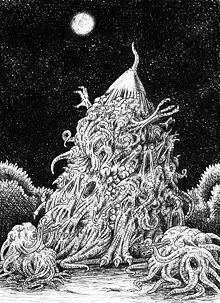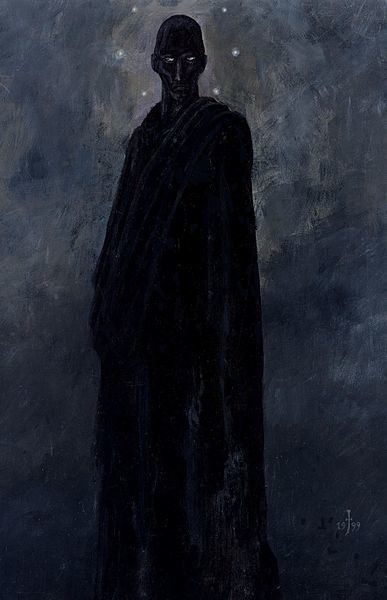Created by H. P. Lovecraft Played by John D. Edge Creator H. P. Lovecraft Movie In Search of Lovecraft | Gender Male First appearance "Nyarlathotep" | |
 | ||
Title Crawling ChaosGod of a Thousand FormsStalker among the StarsBlack PharaohFaceless GodMessenger of the Other Gods Similar Azathoth, Cthulhu, Yog‑Sothoth, Shub‑Niggurath, Cthugha | ||
Nyarlathotep is a character in the works of H. P. Lovecraft and other writers. The character is commonly known in association with its role as a malign deity in the Lovecraft Mythos fictional universe, where it is known as the Crawling Chaos. First appearing in Lovecraft's 1920 prose poem of the same name, he was later mentioned in other works by Lovecraft and by other writers and in the tabletop role-playing games making use of the Cthulhu Mythos. Later writers describe him as one of the Outer Gods.
Contents
- In the work of H P Lovecraft
- Inspiration
- Summary
- The Nyarlathotep Cycle
- Table of forms
- Overview
- In popular culture
- References

Although the deity's name is fictional, it bears the historical Egyptian suffix -hotep, meaning "peace" or "satisfaction."
In the work of H. P. Lovecraft
In his first appearance in "Nyarlathotep" (1920), he is described as a "tall, swarthy man" who resembles an ancient Egyptian pharaoh. In this story he wanders the earth, seemingly gathering legions of followers, the narrator of the story among them, through his demonstrations of strange and seemingly magical instruments. These followers lose awareness of the world around them, and through the narrator's increasingly unreliable accounts the reader gets an impression of the world's collapse.
Nyarlathotep subsequently appears as a major character in "The Dream Quest of Unknown Kadath" (1926/27), in which he again manifests in the form of an Egyptian pharaoh when he confronts protagonist Randolph Carter.
The twenty-first sonnet of Lovecraft's poem-cycle "Fungi from Yuggoth" (1929/30) is essentially a retelling of the original prose poem.
In "The Dreams in the Witch House" (1933), Nyarlathotep appears to Walter Gilman and witch Keziah Mason (who has made a pact with the entity) in the form of "the 'Black Man' of the witch-cult," a black-skinned avatar of the Devil described by witch hunters.
Finally, in "The Haunter of the Dark" (1936), the nocturnal, tentacled, bat-winged monster dwelling in the steeple of the Starry Wisdom sect's church is identified as another manifestation of Nyarlathotep. This avatar can not tolerate the slightest light.
Though Nyarlathotep appears as a character in only four stories and two sonnets, his name is mentioned frequently in other works. In "The Rats in the Walls" (1924), Nyarlathotep is mentioned as a faceless god in the caverns of earth's center. In "The Whisperer in Darkness" (1931), the Mi-Go chant his name in reverential tones, describing him as a non-human entity who takes the form of a man. In "The Shadow Out of Time" (1936), the "hideous secret of Nyarlathotep" is revealed to the protagonist by Khephnes during their imprisonment by the Great Race of Yith.
Nyarlathotep does not appear in Lovecraft's story "The Crawling Chaos" (1920/21), despite the similarity of the title to the character's epithet.
Inspiration
In a 1921 letter to Reinhardt Kleiner, Lovecraft related the dream he had had — described as "the most realistic and horrible [nightmare] I have experienced since the age of ten" — that served as the basis for his prose poem "Nyarlathotep". In the dream, he received a letter from his friend Samuel Loveman that read:
Don't fail to see Nyarlathotep if he comes to Providence. He is horrible — horrible beyond anything you can imagine — but wonderful. He haunts one for hours afterwards. I am still shuddering at what he showed.Lovecraft commented:
I had never heard the name NYARLATHOTEP before, but seemed to understand the allusion. Nyarlathotep was a kind of itinerant showman or lecturer who held forth in public halls and aroused widespread fear and discussion with his exhibitions. These exhibitions consisted of two parts — first, a horrible — possibly prophetic — cinema reel; and later some extraordinary experiments with scientific and electrical apparatus. As I received the letter, I seemed to recall that Nyarlathotep was already in Providence.... I seemed to remember that persons had whispered to me in awe of his horrors, and warned me not to go near him. But Loveman's dream letter decided me.... As I left the house I saw throngs of men plodding through the night, all whispering affrightedly and bound in one direction. I fell in with them, afraid yet eager to see and hear the great, the obscure, the unutterable Nyarlathotep.Will Murray has speculated that this dream image of Nyarlathotep may have been inspired by the inventor Nikola Tesla, whose well-attended lectures did involve extraordinary experiments with electrical apparatus and whom some saw as a sinister figure.
Robert M. Price proposes that the name Nyarlathotep may have been subconsciously suggested to Lovecraft by two names from Lord Dunsany, an author he much admired. Alhireth-Hotep, a false prophet, appears in Dunsany's The Gods of Pegana, and Mynarthitep, a god described as "angry," appears in Dunsany's "The Sorrow of Search."
Summary
Nyarlathotep differs from the other beings in a number of ways. Most of them are exiled to stars, like Yog-Sothoth and Hastur, or sleeping and dreaming like Cthulhu; Nyarlathotep, however, is active and frequently walks the Earth in the guise of a human being, usually a tall, slim, joyous man. He has "a thousand" other forms, most of these reputed to be maddeningly horrific. Most of the Outer Gods have their own cults serving them; Nyarlathotep seems to serve these cults and take care of the deities' affairs in their absence. Most of the gods use strange alien languages, but Nyarlathotep uses human languages and can be mistaken for a human being. The other Outer Gods and Great Old Ones are often described as mindless or unfathomable rather than truly malevolent, but Nyarlathotep delights in cruelty, is deceptive and manipulative, and even cultivates followers and uses propaganda to achieve his goals.
Nyarlathotep enacts the will of the Outer Gods, and is their messenger, heart and soul; he is also a servant of Azathoth, his father, whose wishes he immediately fulfills. Unlike the other Outer Gods, causing madness is more important and enjoyable than death and destruction to Nyarlathotep. It is suggested by some that he will destroy the human race and possibly the earth as well. Brian Lumley described him as the emanation of various Great Old Ones and not an actual being, thus explaining his variety of forms and functions.
The Nyarlathotep Cycle
In 1996, Chaosium published The Nyarlathotep Cycle, a Cthulhu Mythos anthology focusing on works referring to or inspired by the entity Nyarlathotep. Edited by Lovecraft scholar Robert M. Price, the book includes an introduction by Price tracing the roots and development of the God of a Thousand Forms. The contents include:
Table of forms
Nyarlathotep has many forms (some literature refers to these forms as Masks and claims that he has a thousand of them) and is thus known by different avatars.
Overview
This table is organized as follows:
